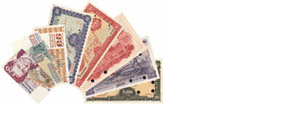

New stuff is being added all the time.
Major Additions of New Sections are Listed in Updates and Contents.
08.04.2025
New section on Northern Ireland Polymer Notes added to the website.
Currently an introduction to the polymer notes now circulating in Northern Ireland, this section will be expanded to cover all the denominations issued by each bank, and will include a detailed study of the security features used on the banknotes.
First Trust Bank ceased issuing banknotes. First Trust is part of AIB group. The bank announced in 2020 that it would end its note issue after nearly 200 years. Its notes in circulation are gradually being withdrawn, and ceased to circulate at midnight on 30th June 2022. After this date the old notes can be exchanged in the bank's branches for current issue notes without time limit.
The first Northern Ireland polymer note was issued by Northern Bank in 1999, in a special issue of two million notes.
Polymer banknotes started to enter circulation again in Northern Ireland in 2019 in a general move by Bank of Ireland, Danske Bank and Ulster Bank to replace their paper note issues with polymer banknotes.
Northern Ireland polymer denominations issued up to 2025 are for each bank are: Danske Bank, £10, £20 notes; Ulster Bank, £5, £10, £20, £50 notes; Bank of Ireland, £5, £10, £20 notes. Paper notes of higher denominations than these remain valid for all three banks.
Two versions of a 2017 Northern Ireland polymer £10 note design was manufactured for First Trust Bank by De La Rue prior to the bank deciding to cease note issue. An example of a proof of each was sold by Noonans (as DNW) in 2020 for £8,000 plus fees.
The latest denomination added to the polymer issues in Northern Ireland is the Ulster Bank polymer £50 note, released in 2022.
The latest date of issue recorded for Northern Ireland polymer notes is on an Ulster Bank £20 note, dated 27 November 2023.
Go to the Northern Ireland Polymer Notes, Dates and Prefixes thread for updates on dates and prefixes of all the denominations of the polymer notes.
Replacement notes of the Polymer banknote series are being traced, and are added on the Polymer Notes forum thread as they are reported. ZZ prefix is being used by Bank of Ireland and Danske Bank on their polymer replacement notes. Ulster Bank appears to not be using a marked replacement note system, and no identifiable Ulster Bank polymer replacement notes have been seen.
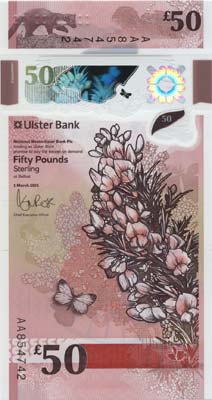
A Census of Surviving Currency Commission Consolidated Bank Notes (Ploughman Notes)
The Ploughman Scan Survey aims to record all surviving Consolidated Bank Notes, by saving an image of each banknote recorded. The survey of Ploughman Irish banknotes has been underway for over 15 years, and is building up a useful database on the Consolidated Ploughman notes which serves as the basis of the Consolidated Bank Note Population Report.
One aim of the survey is to establish the relative rarities of different issues with respect to each other of these Irish banknotes. Another aim is to build up a knowledge base of the grades of surviving notes.
This is the first survey of its kind carried out on old Irish money. With 3902 Ploughman notes recorded so far, and £10,639 face value, it amounts to 10.108% of the total value of Ploughman notes outstanding. Results and updates on the Consolidated Bank Note Population Report are presented in the Ploughman notes forum.
Detailed results are published periodically. The Fifth Edition of 'Irish Banknotes, Irish Papermoney 1928-2001' will include the latest updates on Ploughman notes and the latest Ploughman Note Population Report, based on PSS data.
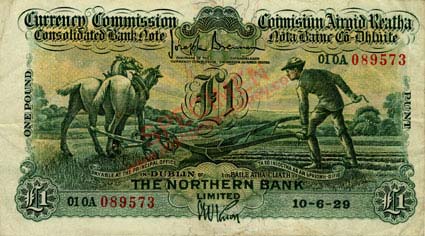
A Ploughman note. The Northern Bank Knox signature One Pound is one of the rarer notes of this series
Three pounds is an unusual denomination in modern times. However, in the 1800s and early 1900s it was quite a common Irish banknote in circulation in the days of old Irish pounds. The denomination ceased to be issued around the time of the first world war.
Several of the Irish joint stock banks issued Irish three pound notes. Some of the Irish private banks also issued Irish banknotes with a denomination of three pounds in the early 1800s.
Of the banks for which three pound notes are recorded in private hands, the rarest is a Bank of Ireland three pound note, with just two examples known.

Bank of Ireland was the largest issuer of banknotes before partition in 1922 and issued a wide range of denominations. The highest known denomination of old Irish Pounds is £500, issued by Bank of Ireland. One date is known for a £500 note, 18 Dec 1869. Other Irish banks issued Irish bank notes up to £100 in value.

Bank of Ireland 500 Pound Note 1869. Image courtesy of the Bank of Ireland
Pictures from the Central Bank of Ireland archive show design mock-ups of several versions of the Irish Series B 100 Pound note. The Series B 100 Pound Note features a portrait of Granuaile. On the reverse is a map of Ireland based on the earliest known example of a map of the island, the 1567 map of Hibernia by John Goghe.

Central Bank of Ireland 100 Pound Note Series B. Image courtesy of the Central Bank of Ireland Archives
The Structure of Irish Currency Issues spans over 300 years. Irish banknotes of the Irish Private banks (ca1670 - ca1836), issued by small banks of six partners or less; Old Banknotes (1783 - 1928), Irish bank notes issued by the Joint stock commercial banks prior to currency partition in 1929; Currency Commission and Central Bank of Ireland Legal Tender Notes (Irish Government issue, 1928 - 2001), and Consolidated Bank Notes ('Ploughman notes', Irish pounds issued by the commercial banks, 1929 - 1941); Northern Ireland notes (issued by the commercial banks, 1929 to the present day).
All old Irish money issued by Irish banks, except that of the private banks, right up to the modern 'Irish Punt' Series C Irish banknotes is redeemable at face value by the issuing bank or its descendants.
The web site main page links to all the Series of paper money of Ireland, and a pictorial history of Irish currency notes which shows the progression of Irish pound note issues starting with those of the private banks such as Ffrench's bank and Maunsell's, later the joint stock commercial banks like the National Bank, through to modern era Government issues and Northern Ireland issues.
The section on the Irish Private Banks is one of the major sections on this website. It draws on the Private Banks Discussions section in the research forum that deals with the Irish paper money issues of the private banks which circulated in Ireland from ca1670 up to ca1836.
Irish private banks were limited to 6 partners or less and merchants were prohibited from engaging in banking by an act of 1756. This made for many small underfunded banks and a relatively weak banking system. The private banks began to be displaced by joint stock banks as note-issuing entities once the latter were permitted by legislation in 1824 allowing private joint stock banks, and in 1825 which permitted public joint stock companies.
For more on the background history of Irish banknotes and the private banks go to the Introduction to Irish Paper Money Issues.
There were over a hundred note-issuing private banks. Almost all of them failed largely due to being poorly capitalised. This resulted in weak backing for Irish pound notes issued by many of these banks. A few of the private banks were well-run and these were wound up and closed in an orderly manner, or merged into newly formed joint stock banks after the 1820s.
Among the most successful of the private banks was La Touche, in business for over 170 years, and Beresford's - Ball's Bank, which operated for around 100 years. One of the most well-known failures was that of Ffrench's Tuam Bank.
One of the private banks, Montgomery's Northern Bank, converted itself into The Northern Banking Company, a private joint stock bank, in 1824. It was Ireland's first joint stock bank since the foundation of the Bank of Ireland in 1783.
One of the last of the Irish private banks to issue notes was Gibbons & Williams in 1833. It was also one of the most spectacular failures among the note-issuing banks, lasting less than two years in business.
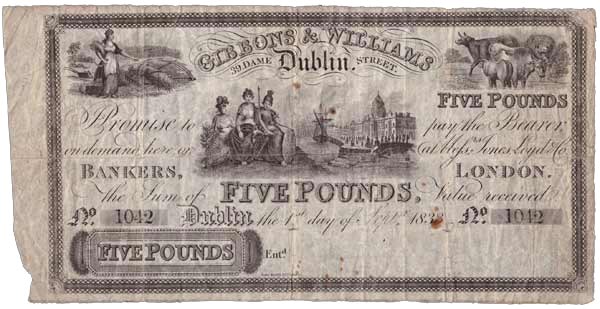
After centuries of a single Irish currency on the island of Ireland, in 1929 Northern Ireland currency and southern Ireland currency were split. The parliament of Southern Ireland never governed, as the area designated as Southern Ireland was declared independent by the winning parties after a general election in Ireland in 1918. 'Southern Ireland' later became the Irish Free State in 1922, and introduced the Irish Pound in 1928 as a legal tender currency, linked at par with the pound Sterling. This new Irish currency, Series A, is known as the Lady Lavery series of Irish pound notes.
Since 2002, the currency of southern Ireland, the Republic of Ireland, as distinct from Northern Ireland has been the Euro. Northern Ireland is part of the UK, and the currency of Northern Ireland is the UK Pound Sterling.
Before Ireland joined the Euro in 2002, the Irish currency in southern Ireland, the Republic of Ireland, was the Irish Pound, or Irish Punt.
At the time of the establishment of the Irish Free State there already existed a sophisticated banking system throughout the island of Ireland, which utilised the English Pound Sterling as a currency in various different forms. Sterling had been Legal Tender in Ireland since 1826. Before this, there had been an Irish Pound which was separate from the Pound Sterling, and had had a different value to it.
During British rule a great variety of banknotes circulated in Ireland from at least 1709 onwards, issued by small private banks and the Bank of Ireland from 1783. Currency stability had been attained by the time of the Bankers (Ireland) Act, 1845, which built on earlier acts and regulated the issue of paper money in Ireland. Banknotes then were issued by six large joint stock commercial banks under license from and control of the Bank of England. English currency also circulated in small quantities.
After Irish independence in 1921 the need for a distinctive Irish currency and an authority to control it became apparent.
A Banking Commission was appointed on 8 March 1926 by the Minister for Finance to study the matter. The Banking Commission recommended the establishment of a new currency, the Saorstát Pound, linked at parity to British Sterling, and an issuing authority, the Currency Commission, to oversee the new note issue.
The Irish Pound was divided into 20 shillings, and issued in seven denominations, 10 Shillings, £1, £5, £10, £20, £50, and £100. This was the first time that a 10 Shilling note denomination was issued in Ireland.
The 1927 Currency Act provided for the creation of the Irish Saorstát Pound, and of the Currency Commission. The circulating old Irish currency was split between the Irish Free State and Northern Ireland. All existing notes issued by the joint stock banks were to be withdrawn and replaced by two new note issues, one for each jurisdiction.
The Currency Commission was created and started to issue Irish Legal Tender Notes in 1928 (known as the 'Lady Lavery' series or 'Lavery Pound note').
In 1929 the Associated (commercial banks) Banks' issues on the island of Ireland were replaced by Consolidated Banknotes controlled by the Currency Commission in the Irish Free State, and a new issue in Northern Ireland, regulated by the Bank of England.
Lady Lavery Pound note, Legal Tender Note, Series A
The Central Bank Act, 1942 established the The Central Bank of Ireland in place of the Currency Commission and provided for the withdrawal of the right of note issue from the commercial banks, leaving the Legal Tender Notes the only banknotes issued in the Republic of Ireland, with notes of the commercial banks being issued in Northern Ireland only.
With parity of value between Sterling and the Irish Pound, Northern Ireland notes and Bank of England notes always continued to circulate in southern Ireland, though the currency of southern Ireland did not circulate in Britain or Northern Ireland.
The Lavery Pound note design (Series A) was replaced by a more modern design from 1976 (Series B), sometimes referred to as the 'Irish Punt' series because the notes were printed entirely in Irish on the face. Reverse printing was entirely in English.
The first Irish Punt series was succeeded by a second Irish Punt design (Series C) from 1992, again printed in Irish on the face and in English on the reverse.
Parity with Sterling continued up until Ireland became part of the ERM in 1979, breaking the link with Sterling. Ireland went on to be a founding member of the Euro zone in 2002, which lead to the replacement of the Irish Pound, or Irish Punt, in circulation by the Euro. The last Irish Punt note to be issued was a £50 note, dated 8 March, 2001. The first issue of Irish Euro notes used prefix letter T, and was issued in denominations of 5, 10, 20, 50, 100, and 500 Euro. 200 Euro notes were not printed with prefix letter T.
One of the more interesting things about Irish banknotes is that every Irish banknote has a date on it. This gives collectors a lot of extra scope for planning their collecting of old Irish money. The reason for the dates on Irish bank notes is most likely security, with each date corresponding to a particular prefix or group of prefixes.
Irishpapermoney.com aims to present an image of every date of each series of the Legal Tender Notes and Consolidated Banknotes. There is a complete set of pictures of Series B Irish banknotes and of Series C on the website, with an almost complete set of Series A Irish banknotes.
Usage of dates of issue continued right up to the last Series C Irish Punt note, the Series C 50 Pound note issued in 2001.
The Lavery Legal Tender Notes, Series A, Irish bank notes are widely regarded as being one of the great world series of banknotes, being issued more or less unchanged for 50 years, from 1928 to 1977, with the £100 note remaining in circulation until 1995. They have consistently been the most popular series of old Irish pounds among Irish collectors.
In addition to these, the Ploughman series (1929 - 1941) is also an attractive and highly sought-after series of old Irish money. Both the Lavery and Ploughman series of Irish bank notes fall within the interest of Commonwealth collectors.
During the second world war a special marking was added to Legal Tender notes, a letter in a circle, creating an interesting variation to the basic design, the Irish War Code Notes.
A Common Question. It depends on how nice it is, and on how old it is!
A thread on the board lists the current numismatic value of Irish 10 shilling notes.
Occasional books on Irish bank notes are available directly from this website and from some numismatic booksellers. Some out of print books are also available. A regular soft cover catalogue of Irish bank notes, 'Irish Banknotes, Irish Papermoney 1928 - 2001', is updated approximately once every three years. The fifth edition will be available in early 2025.
The Irish World War II 'War Code' Banknote Issues, 1940 - 1944
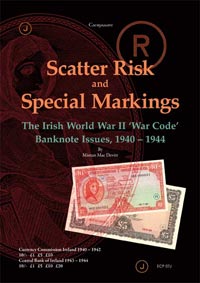
1 Pound Ploughman
5 Pounds Ploughman
10 Pounds Ploughman
20 Pounds Ploughman
50 Pounds Ploughman
100 Pounds Ploughman
Irish Ten Shilling Notes
1 Pound Note Lady Lavery
5 Pounds Lady Lavery
10 Pounds Lady Lavery
20 Pounds Lady Lavery
50 Pounds Lady Lavery
100 Pounds Lady Lavery
1 Pound Note, Queen Medb
5 Pound Note, John Scotus Eriugena
10 Pound Note, Jonathan Swift
20 Pound Note, W. B. Yeats
50 Pound Note, Turlough O'Carolan
100 Pound Note, Grace O'Malley
5 Pound Note, Sister Catherine McAuley
10 Pound Note, James Joyce
20 Pound Note, Daniel O'Connell
50 Pound Note, Douglas Hyde
100 Pound Note, Charles Stewart Parnell
Northen Ireland Polymer notes
Bank of Ireland Polymer Notes
Danske Bank Polymer Notes
Ulster Bank Polymer Notes
Special Sections and Articles
The Transition of Irish Currency, Irish banknotes 1918–1928
The Partition of Irish Currency, Irish banknotes 1928–1930
Banknote Design Evolution 1824 to 1916
Irish Three Pound Notes
Contemporary Forgeries of Early Irish Banknotes, ca1800-1930
Limerick Soviet Notes
Irish World War 2 Banknote Issues
Low Number Irish Banknotes
Irish Joint Stock Banks of Note Issue from 1783
Irish Legal Tender Note Specimens
Ploughman Scan Survey (PSS)
Many of the banknotes illustrated in the Private Banknotes section, and some of the banknotes illustrated in the Old Notes section and elsewhere on the website, are reproduced from auctions by Noonans, Mayfair (formerly DNW), Whyte's, Dublin, and Spink, London. Other illustrations are from Bank of Ireland, the Central Bank of Ireland, the National Museum of Ireland, and scans from private collections.
Specimens of Irish Legal Tender Notes and Consolidated Bank Notes are courtsey of The Central Bank of Ireland. Almost all other Legal Tender Note and Consolidated Banknote images are sourced from private collections or from the Central Bank of Ireland.
Extra banknote pictures are being added constantly, as they are loaned by collectors, museums, and archives, and are found on the web. Please submit missing dates and images via the forum, or by email.
![]()